« Africa Photos - 9 | Main | Out Of Africa - Karen Blixen »
March 17, 2007
Into Out Of Africa
Into "Out Of Africa" - what's all that about, then? Well, the 1985 film of that name, and the 1937 book, a memoir by Isak Dinesen (the pseudonym of Danish Baroness Karen von Blixen-Finecke), were both set in the region of Africa that I am in at the moment: Nairobi, and the area around it, especially the Ngong Hills. More about "Out Of Africa" later: first some news and updates.
I had quite a few emails and messages wondering whether I was involved in the recent kidnapping of 4 British travellers whilst they were sleeping next to their vehicles in northern Ethiopia recently. Luckily, no, that wasn't anything to do with me, though we were in that very area just a couple of weeks before the kidnap took place. Thanks for everyone's enquiries, and good wishes, which were gratefully received, and which I send myself to the families of those involved.
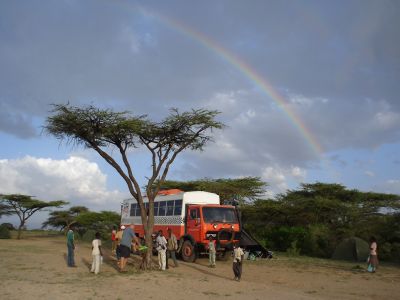
Truck at Lake Shala National Park
Life on the truck will be changing quite dramatically next week. The original leader of the expedition, Nigel, and his lover, and her best friend, have flown to Cape Town to pick up an Encounter Overland truck that is due to travel north to Namibia. This leaves behind Zoe - the trainee-driver on her first trip out of England, with only 3 months experience of driving in Africa. She is now to single-handedly drive the truck all the way to Cape Town, with no backup of any sort, and to rectify any mechanical problems that we may encounter along the way. She has no previous mechanical experience, apart from the short training period in the Dragoman workshop, and what she has seen along the way. We all hope that she is indeed up to the job, but everybody feels that it is very premature of Dragoman to give such responsibility to someone with such little experience,even though in time she will no doubt make an excellent trip-leader. I would encourage all readers of this blog to keep their fingers crossed for us during the next 3 months!
'Us' - who is us? Well, the number of passengers dropped dramatically when the Addis-Nairobi section ended, and the next section of this adventure, from Nairobi to Victoria Falls, will have just 5 passengers: myself, Harry, Margaret, and 2 new people who are arriving shortly in Nairobi. No doubt we will be rattling around in a truck that is meant to hold up to 24, though at least there will be plenty of empty seats to choose from. All the usual jobs on a truck that are normally carried out by the passengers will still need to be done, of course, so we will all have to take 2 or 3 on. In case you are wondering, the jobs on the truck are normally selected from the following: kitty management, bulk food management, security, cook-equipment setup, window cleaning, rubbish disposal, firewood and fire organiser, fridge cleaning, storage box cleaning, tent management, stools setup, daily truck cleaning, baggage and back-locker loading.
The other news is that we will be getting an African cook for the next section, and possibly all the way down to Cape Town as well. This is something new for me: I have always cooked in groups of 2 or 3 on my other Overland journeys, taking it in turns with everyone else. I enjoy the cooking, and I enjoy making interesting vegetarian food with whatever local ingredients are available in the markets we pass through. Cooks are very much the norm in East Africa, though, and as there are so many Overland companies that go through East Africa, and as they all have cooks, the Dragoman trucks have to have one as well. Just what having a cook on the truck is actually like, and what his cooking is like too, will be related in my next blog so watch this space for further details. And no, he won't be doing any of the driving.
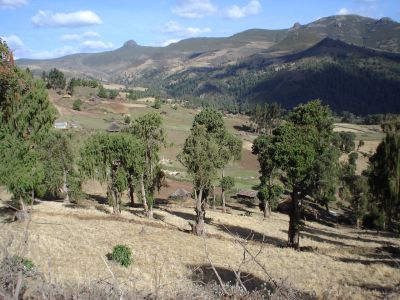
Bale Mountains National Park
If any of you have been wondering just why there haven't been many emails from me lately, the answer is that for most of the last section of this adventure, we have been away from internet cafes and 'civilisation' generally, and have spent most of the time camping in the bush, and watching the various animals for which East Africa is so famous. We started out in the Bale Mountains National Park in Ethiopia, where we saw warthogs, reedbuck, dik-diks, and the famous Ethiopian wolf. Next, we travelled to Arba Minch, the city of Forty Springs, that is set between 2 great lakes Abaya and Chamo. There we saw crocodiles up to 7 metres in length, a variety of amazing and colourful birds, and, for a very special moment, my first ever wild zebra *WHILST* listening to the theme-music from 'Out Of Africa' on a borrowed iPod. How neat is that, eh?! (More 'Out Of Africa' stuff shortly...)
From Arba Minch we travelled to the Omo Valley, which is part of the Great Rift Valley, and home to a number of tribes that still live and survive by traditional methods. We were able to visit a few of these tribes, and learn a bit about how they survive in such a harsh environment, and how they live from day to day in a manner and using techniques that haven't changed for hundreds if not thousands of years.
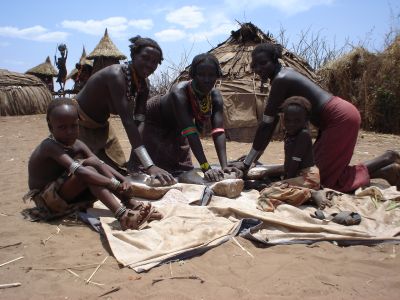
Grinding Tef into flour
Once out of the Omo Valley, we left Ethiopia and entered Kenya. I was sorry to leave, as we all had a wonderful time in that country, experiencing the amazing scenery and the wonderful, friendly people throughout our visit. Kenya is quite different from Ethiopia - quite a bit more prosperous for one thing, though much of that prosperity still seems to be in the hands of the European settlers and businessmen who run the numerous flower farms and french-bean farms that regularly waste the earth's finite resources of fossil fuel to fly their flowers and beans back to the over-stocked markets of Europe. Please boycott them! The people of Kenya, though pleased to work in the flower farms and spray chemicals all over the lands to end up in the rivers, watercourses and lakes, would no doubt like a little more control of their own destiny, though. One way that can happen is to employ more Kenyan people in what is one of their country's greatest resources: the many national parks and game reserves where the abundant wildlife lives in conditions vital for their future survival.
We have been visiting some of the game parks recently. See the latest Photo Pages where I have posted a few pictures. So far, we have been to the Samburo, Nakuru, and Lake Naivasha National Parks. Each was quite different. In the Samburo Park we drove around in the truck, and despite the noise of its engine we were able to get quite close to zebra, elephants, various gazelles and antelopes - even some lions! As you might expect, no one was allowed to leave the vehicle, though that night we were camped by the Samburo River, and in the morning saw leopard tracks through the camp - isn't it a good thing we have such sturdy canvas tents. (Yikes!)
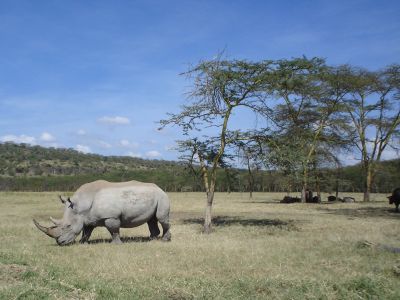
A white rhino
Nakuru National Park is much bigger, and we had to use 2 minivans with a local driver to explore. Lots of flamingo feed around the shores of the lake, and present a truly spectacular sight. With only a semi-wide angle lens on my camera, I couldn't get any closeups, but my 10x50 binoculars were in constant use. We also saw some white rhinos, lots of buffaloes, some different giraffes, but no leopard. Perhaps we will be lucky in future - watch this space. Actually, though, I am just as happy to see the scenery, the trees and the birds as any exotic predators. Especially if we are camping in the middle of them!
Lake Naivasha held its own set of dangers - numberous hippos, who wander about the lake shore after dusk. These seemingly mild creatures are actually one of Africa's most dangerous, and are responsible for more tourist-deaths than any other creatures, so we all kept a respectful distance, and didn't wander about by the lake after dark.
Now I'm in Nairobi, or 'Nairobbery' as it is known by travellers. So far all is well, as we are taking great care when walking through this modern city, and staying in after dusk. There may well be hippos out there too, but I am not going to look.
'Out of Africa' fans may be getting rather fed up at this point, but don't despair - the promised mention is coming up right now...
I went to visit Nairobi's excellent Railway Museum, which is very well laid out, and has a large number of exhibits both inside and out. The inside hall has many photos of Kenyan and Ugandan steam trains and buildings, plus quite a few interesting items such as the table and sideboard from the SMS 'Konigsberg' warship, and the wooden seat that was strapped to the front of steam locos in Kenya to allow visiting dignitaries such as King George V and President Theodore Roosevelt to shoot at passing wildlife as the train progressed through the countryside.
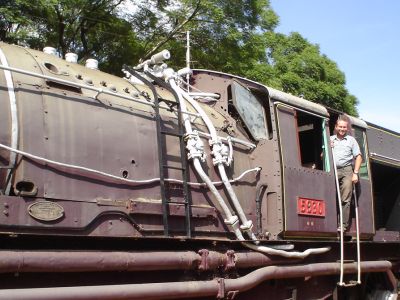
On the footplate of a Beyer Garret
Outside were a number of steam locomotives and carriages - the most famous being a few of the huge articulated Beyer Garratts, that were needed to cope with the high altitudes found on the lines here - up to 9000' in some cases. They all had compressed-air braking systems, driven by steam, as the usual vacuum brakes just wouldn't work at altitude.
Also, there is locomotive number 301, which was used in the film 'Out of Africa' (yes, at last), and also the 1st and 3rd class carriages that made up part of the train.
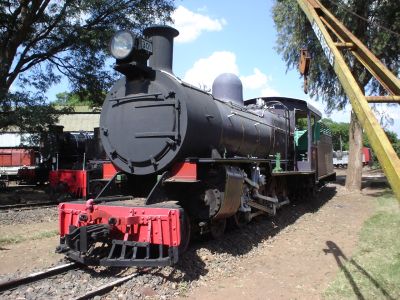
Loco used in film 'Out of Africa'
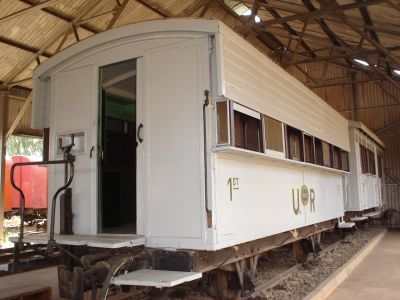
Carriages used in film 'Out of Africa'
I hope to visit Karen Blixen's house in the next few days, and see the Ngong Hills. Watch this space for further details.
One thing I did manage to do in Nairobi was to check at the Post Restante counter to see if there was any mail waiting for me. This time yes (whoopee) - there were 3 letters, from Dennis Searle, Steve Treloar, and Margaret Makins. I checked mail on 19/03/07 but we leave Nairobi later that day, so any late arrivals should hopefully be returned to the senders after a month of so - if you receive your letter back, please let me know. If you would like to send me a letter to one of the future mail-stops, (all most welcome) go to this page for the next address, which is Victoria Falls, in Zimbabwe, and for the ones that follow.
Posted by travellingtim at March 17, 2007 12:28 PM
